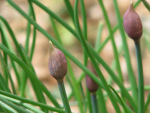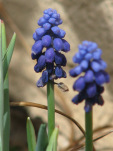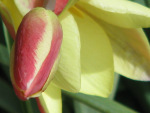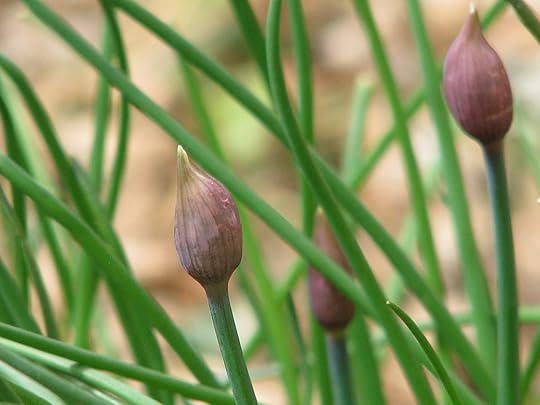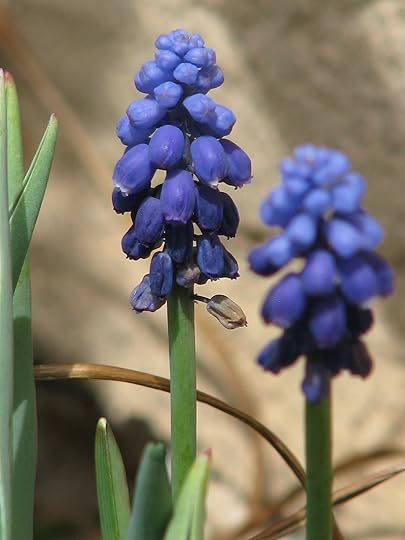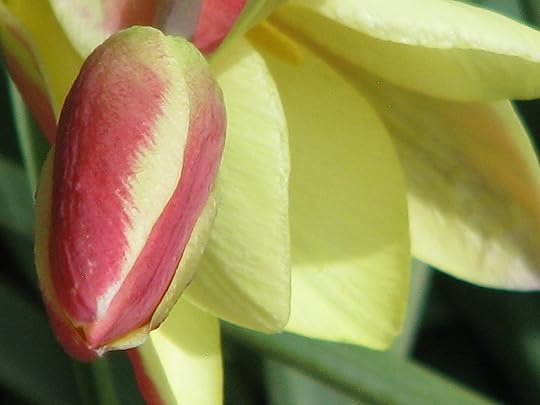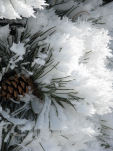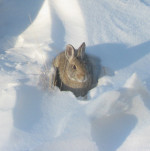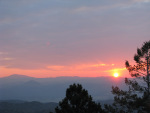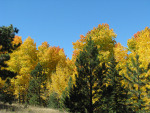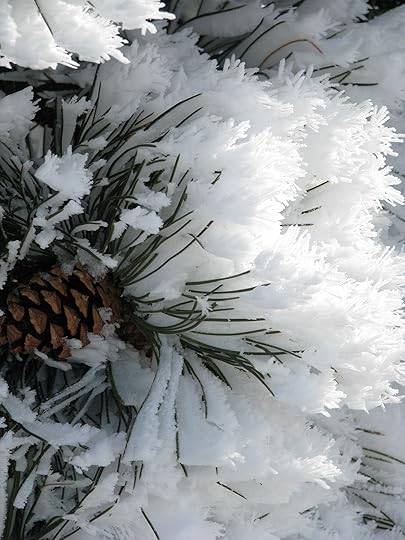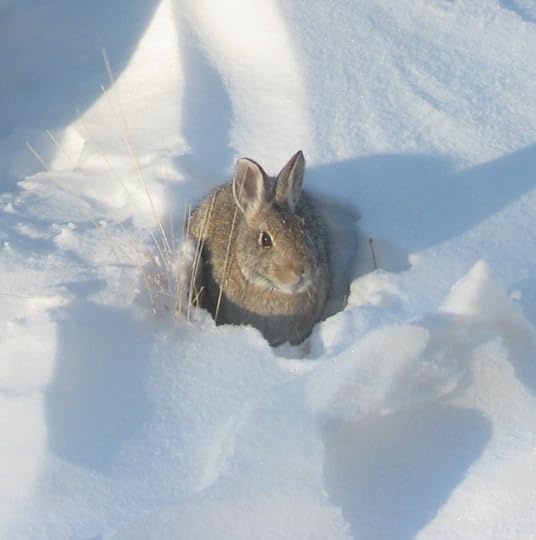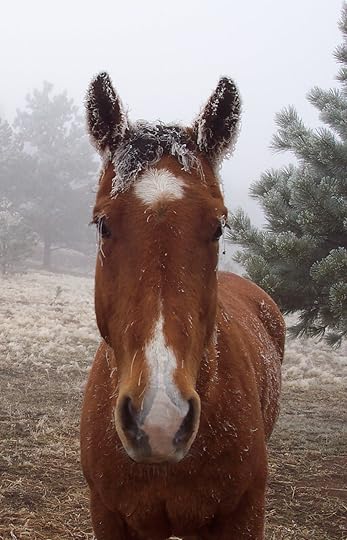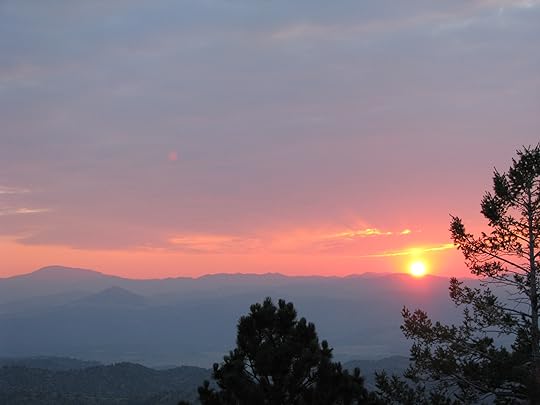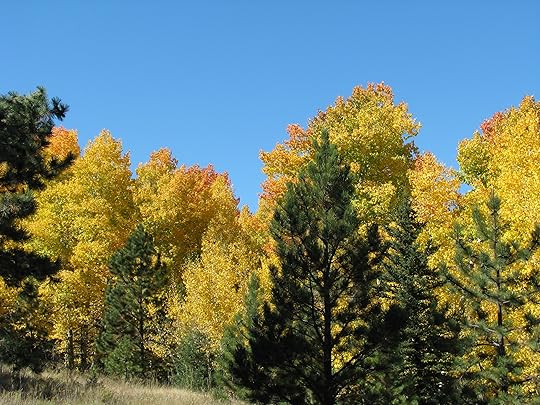Andrea M. Jones's Blog, page 12
May 11, 2016
Winterspring
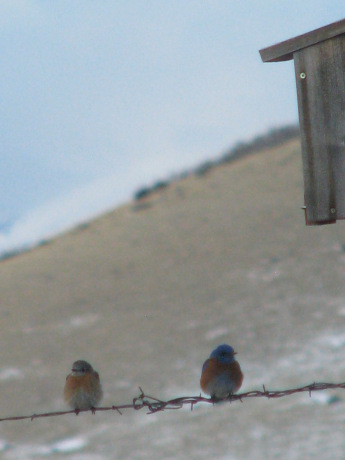
The winners of this box, this year: Western bluebirds.
From a distance, not much has changed. Almost-mid-May from the house looks pretty much like just-past-mid-March. The difference, as it so often is, is in the details. The expanses of grass, passive and still eight weeks ago, are now host to fluttering, creeping, scurrying. The birds are back, the bugs are getting busy, and the rodents are out and about again.
After a few weeks of fierce squabbles, with males wing-beating one another to the ground, pairs of bluebirds have claimed the local nest boxes: Western bluebirds up near the house, Mountain bluebirds down by the barn. The couples are busy setting up the summer’s household and gleaning insects from the bunchgrasses.
Chipmunks, voles, and pocket gophers are on the move, a development less charming to me since they eat plants I want instead of insects I don’t. I’m not the only one who’s noticed them, however. I’ve seen as many as three red-tailed hawks at a time contemplatively soaring over the pastures south and west of the barn. I’m sorry to report to the soft-hearted among you that the gophers squeaking in alarm fills my heart with glee.
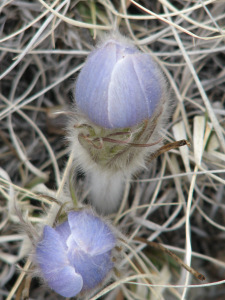 The pasqueflowers have popped up, running a little late. I don’t know what to read from the timing of their bloom, whether it’s a report on conditions from the passing winter, or a prediction about the coming summer, but I do know the fuzzy lavender cups elicit a surge of fondness out of proportion to their subtle color and modest stature.
The pasqueflowers have popped up, running a little late. I don’t know what to read from the timing of their bloom, whether it’s a report on conditions from the passing winter, or a prediction about the coming summer, but I do know the fuzzy lavender cups elicit a surge of fondness out of proportion to their subtle color and modest stature.
Inside the garden walls, the snippets of color I was so desperately seeking two months ago have emerged in extravagant displays—concentrated and contained, to be sure, islands of green and purple and red and yellow scattered in the seas of brown that are the unplanted vegetable beds—but reassuringly bright. No worries, the tulips and chives and muscari and rhubarb seem to say, We’re back.
This is the Rocky Mountains, though, and even if springtime arrives with the heavy symbolism of renewal it carries throughout the temperate zones, this is perhaps the most fickle time of year in a region notable for its fickleness of weather. Sunshine one day is followed by gloom or fog or snow flurries the next. The temperature wanders up and down so fast I step outside to assess before I go for a walk: jacket and sun hat, or coat and woolly cap? Optimistic plans for washing blizzard-flung sludge off the windows or puttering in the garden, formed of a sunny dawn, are blown flat by a cold gale before I’ve finished my morning tea.
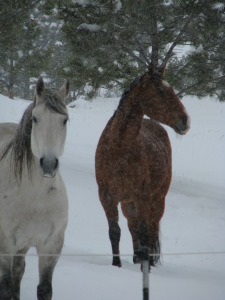
Ready for dinner, April 29.
And at this elevation, of course, April showers arrive in solid form.
As I prowled the garden happily in the waning days of April, framing pictures of the color I’d been craving for weeks, I knew change was in store. I’d been watching the forecast.
The snow started on Wednesday night, disintegrating to slush against the warm ground. The pace of accumulation was faster than the melting, and insulating batts thickened atop the slush. By dark on Friday we had more than twelve inches of wet spring snow on the ground, the biggest snowfall of the winter. Thanks to that one storm, we collected more snow in April than in January, February, and March combined.
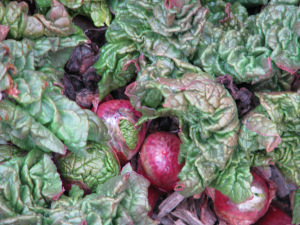
The rhubarb patch, late April.
The snow never stopped melting from underneath, and didn’t last long. Within a few days, the splashes of color in the garden were back on display, even if the foliage was a bit flatter and bore some kinks and crimps.
I’m glad of the speedy re-emergence of color, whether it’s the blare of daffodils or the blue flash of a Mountain bluebird’s breeding plumage or the rhubarb’s red and green umbrellas slowly uncrinkling. Yet I find myself—fickle me!—also plotting how to hang on to the last vestiges of winter. This sounds ludicrous, given how long I’ve been itching for signs the season will end. But winter here is also water and, satisfied the world will not remain monochrome forever, my thoughts have now turned toward mulch. Dead, yes. Brown, also yes. But effective, too, at holding moisture, protecting the surface soils from the high-altitude solar intensity that’s on its way and the winds that never, really, stop. Those winds will slow down a little now, though, relaxing from their mulch-stripping pace. The blank spaces of the vegetable beds and the now-exposed flowerbeds around the house are crying out for a spring-weight blanket, a covering layer that will help them preserve the wet of snowmelt mud as long as possible.


Winterspring
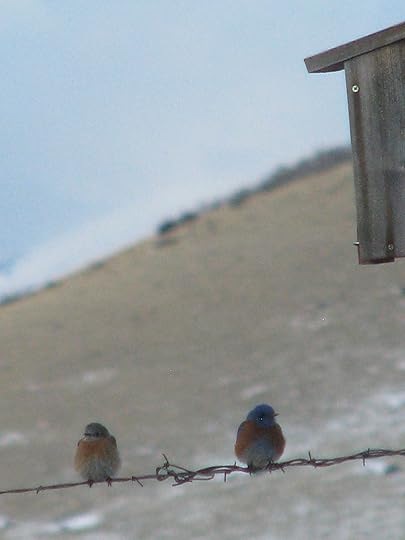
The winners of this box, this year: Western bluebirds.
From a distance, not much has changed. Almost-mid-May from the house looks pretty much like just-past-mid-March. The difference, as it so often is, is in the details. The expanses of grass, passive and still eight weeks ago, are now host to fluttering, creeping, scurrying. The birds are back, the bugs are getting busy, and the rodents are out and about again.
After a few weeks of fierce squabbles, with males wing-beating one another to the ground, pairs of bluebirds have claimed the local nest boxes: Western bluebirds up near the house, Mountain bluebirds down by the barn. The couples are busy setting up the summer’s household and gleaning insects from the bunchgrasses.
Chipmunks, voles, and pocket gophers are on the move, a development less charming to me since they eat plants I want instead of insects I don’t. I’m not the only one who’s noticed them, however. I’ve seen as many as three red-tailed hawks at a time contemplatively soaring over the pastures south and west of the barn. I’m sorry to report to the soft-hearted among you that the gophers squeaking in alarm fills my heart with glee.
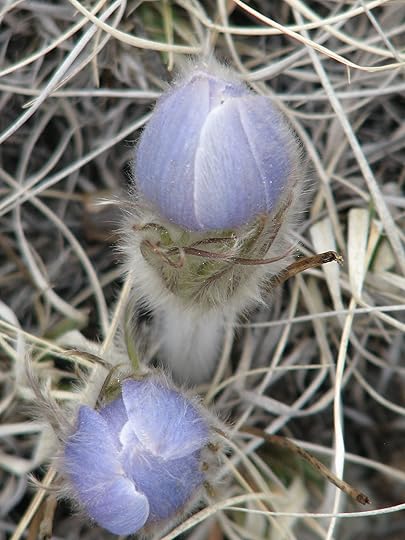 The pasqueflowers have popped up, running a little late. I don’t know what to read from the timing of their bloom, whether it’s a report on conditions from the passing winter, or a prediction about the coming summer, but I do know the fuzzy lavender cups elicit a surge of fondness out of proportion to their subtle color and modest stature.
The pasqueflowers have popped up, running a little late. I don’t know what to read from the timing of their bloom, whether it’s a report on conditions from the passing winter, or a prediction about the coming summer, but I do know the fuzzy lavender cups elicit a surge of fondness out of proportion to their subtle color and modest stature.
Inside the garden walls, the snippets of color I was so desperately seeking two months ago have emerged in extravagant displays—concentrated and contained, to be sure, islands of green and purple and red and yellow scattered in the seas of brown that are the unplanted vegetable beds—but reassuringly bright. No worries, the tulips and chives and muscari and rhubarb seem to say, We’re back.
This is the Rocky Mountains, though, and even if springtime arrives with the heavy symbolism of renewal it carries throughout the temperate zones, this is perhaps the most fickle time of year in a region notable for its fickleness of weather. Sunshine one day is followed by gloom or fog or snow flurries the next. The temperature wanders up and down so fast I step outside to assess before I go for a walk: jacket and sun hat, or coat and woolly cap? Optimistic plans for washing blizzard-flung sludge off the windows or puttering in the garden, formed of a sunny dawn, are blown flat by a cold gale before I’ve finished my morning tea.
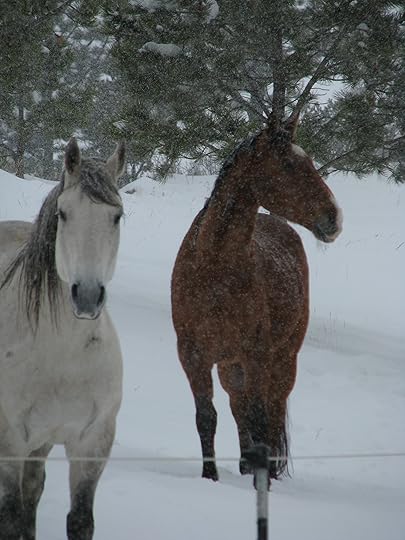
Ready for dinner, April 29.
And at this elevation, of course, April showers arrive in solid form.
As I prowled the garden happily in the waning days of April, framing pictures of the color I’d been craving for weeks, I knew change was in store. I’d been watching the forecast.
The snow started on Wednesday night, disintegrating to slush against the warm ground. The pace of accumulation was faster than the melting, and insulating batts thickened atop the slush. By dark on Friday we had more than twelve inches of wet spring snow on the ground, the biggest snowfall of the winter. Thanks to that one storm, we collected more snow in April than in January, February, and March combined.
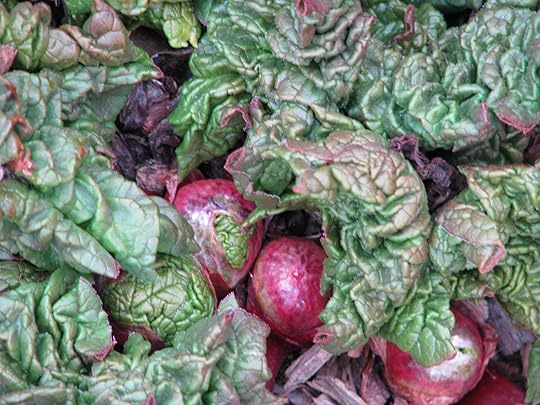
The rhubarb patch, late April.
The snow never stopped melting from underneath, and didn’t last long. Within a few days, the splashes of color in the garden were back on display, even if the foliage was a bit flatter and bore some kinks and crimps.
I’m glad of the speedy re-emergence of color, whether it’s the blare of daffodils or the blue flash of a Mountain bluebird’s breeding plumage or the rhubarb’s red and green umbrellas slowly uncrinkling. Yet I find myself—fickle me!—also plotting how to hang on to the last vestiges of winter. This sounds ludicrous, given how long I’ve been itching for signs the season will end. But winter here is also water and, satisfied the world will not remain monochrome forever, my thoughts have now turned toward mulch. Dead, yes. Brown, also yes. But effective, too, at holding moisture, protecting the surface soils from the high-altitude solar intensity that’s on its way and the winds that never, really, stop. Those winds will slow down a little now, though, relaxing from their mulch-stripping pace. The blank spaces of the vegetable beds and the now-exposed flowerbeds around the house are crying out for a spring-weight blanket, a covering layer that will help them preserve the wet of snowmelt mud as long as possible.
May 8, 2016
Good News Follow-up
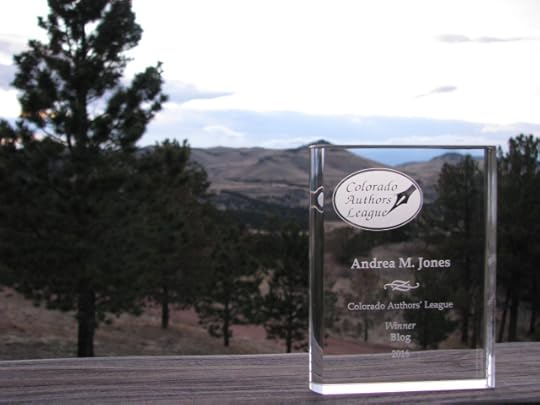 On Friday, May 6, the Colorado Authors’ League (CAL) announced the winners of their 2016 Writing Awards, and I was honored to be recognized for this blog.
On Friday, May 6, the Colorado Authors’ League (CAL) announced the winners of their 2016 Writing Awards, and I was honored to be recognized for this blog.
My sincere thanks to CAL for all the work the organization does to support and recognize Colorado Authors, and big congratulations to all the other finalists and winners!


Good News Follow-up
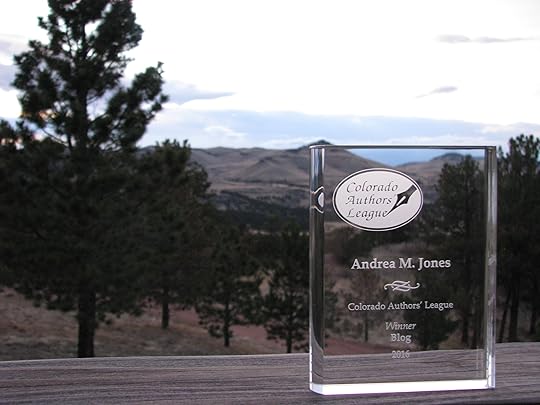 On Friday, May 6, the Colorado Authors’ League (CAL) announced the winners of their 2016 Writing Awards, and I was honored to be recognized for this blog.
On Friday, May 6, the Colorado Authors’ League (CAL) announced the winners of their 2016 Writing Awards, and I was honored to be recognized for this blog.
My sincere thanks to CAL for all the work the organization does to support and recognize Colorado Authors, and big congratulations to all the other finalists and winners!
April 25, 2016
A Little Good News
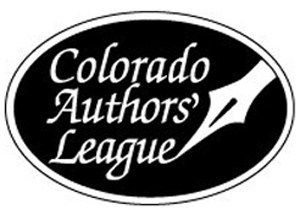 In early April, I learned that my project here has been named a finalist in blog category of the 2016 Writing Awards sponsored by the Colorado Authors’ League (CAL).
In early April, I learned that my project here has been named a finalist in blog category of the 2016 Writing Awards sponsored by the Colorado Authors’ League (CAL).
There will be a reading event at BookBar in Denver, Colorado (click here for details), on Saturday, April 30, 2016 . Finalists in the the Feature Article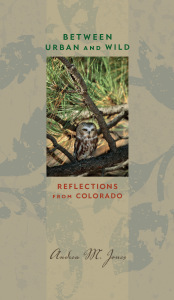 , Blog, and Essay categories will be reading and discussing their work. The event runs from 2:00 until 4:00 p.m., and authors who have also written books will have them available for sale and signing (that includes me, with Between Urban and Wild the book). This will be a fun celebration of Colorado writers, so if you’re in Denver, stop by!
, Blog, and Essay categories will be reading and discussing their work. The event runs from 2:00 until 4:00 p.m., and authors who have also written books will have them available for sale and signing (that includes me, with Between Urban and Wild the book). This will be a fun celebration of Colorado writers, so if you’re in Denver, stop by!
Founded in 1931 to “foster the art and craft of authorship,” the Colorado Authors’ League is celebrating its 85th Anniversary this year. The organization fosters networking and learning opportunities for its members and works to and develop creative writing through education and events.
The 2016 Awards recognize work published the previous calendar year. The 2015 blog posts included in my “Between Urban and Wild” (the blog) entry were:
CAL Writing Award Winners will be announced at the annual CAL banquet in Denver on May 6, 2016.


A Little Good News
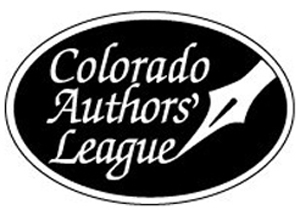 In early April, I learned that my project here has been named a finalist in blog category of the 2016 Writing Awards sponsored by the Colorado Authors’ League (CAL).
In early April, I learned that my project here has been named a finalist in blog category of the 2016 Writing Awards sponsored by the Colorado Authors’ League (CAL).
There will be a reading event at BookBar in Denver, Colorado (click here for details), on Saturday, April 30, 2016 . Finalists in the the Feature Article , Blog, and Essay categories will be reading and discussing their work. The event runs from 2:00 until 4:00 p.m., and authors who have also written books will have them available for sale and signing (that includes me, with Between Urban and Wild the book). This will be a fun celebration of Colorado writers, so if you’re in Denver, stop by!
, Blog, and Essay categories will be reading and discussing their work. The event runs from 2:00 until 4:00 p.m., and authors who have also written books will have them available for sale and signing (that includes me, with Between Urban and Wild the book). This will be a fun celebration of Colorado writers, so if you’re in Denver, stop by!
Founded in 1931 to “foster the art and craft of authorship,” the Colorado Authors’ League is celebrating its 85th Anniversary this year. The organization fosters networking and learning opportunities for its members and works to and develop creative writing through education and events.
The 2016 Awards recognize work published the previous calendar year. The 2015 blog posts included in my “Between Urban and Wild” (the blog) entry were:
CAL Writing Award Winners will be announced at the annual CAL banquet in Denver on May 6, 2016.
April 9, 2016
Between Urban and…Urban
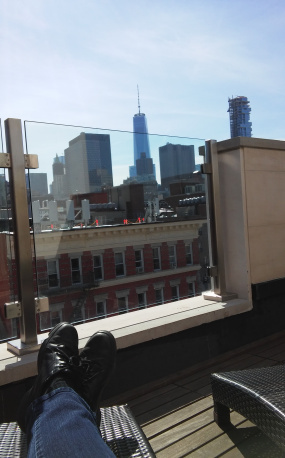
Relaxing on the terrace, looking on to the new One World Trade Center tower (center).
Even though we live in the sort of place most people escape TO, my hubby and I feel the impulse for a break now and then. Sometimes the change of place from this semi-arid ridge in central Colorado’s mountains is wet and coastal and occasionally it’s foreign, but often it’s a short city break. We eat in restaurants, take long walks on chewing-gum-freckled sidewalks, rely on public transportation.
There’s plenty about these trips that unsettles me. The charms of air travel withered long ago. I sleep poorly in noisy and over-illuminated cities. I’m distressed at how much harder it is to minimize my participation in the disposable economy while traveling. I’m unnerved by the press of people. I dislike the persistent befuddlement of being stripped of my insider’s native confidence. Yet for the brief interlude of a few days, spending time someplace that bears no resemblance to where we live, be it by sight, sound, smell, or rhythm, can be revitalizing.
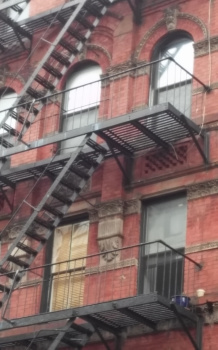
New York tenement neighborhood.
At the end of March, Doug and I flew to New York City to spend a few days in the urban frenzy and to visit my mom and brother. Doug had scored an online deal for a hotel and our time there aligned with a couple of days of fine spring weather. We socialized with family and friends and visited a couple of museums, but spent a lot of time wandering the streets, taking in the bustle and intricate choreography of that frenetic and assertively urban environment. In our temporary local neighborhood, we strolled past stores selling durian fruit, used restaurant equipment, shoes, high-end lighting, fancy clothes, cannolis. We strode streets and ambled avenues while dodging workers, tourists, bikes, food carts, and forests of steel construction scaffolding sprouting on walkways in every neighborhood. We squinted in the glare of glass-clad high-rises, admired the rusting fretwork of fire escapes on refurbished brick tenements, and noted that construction fashion trends have brought concrete back in vogue.
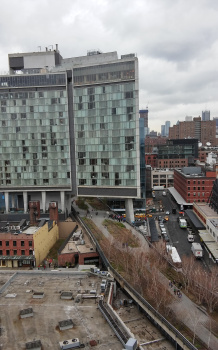
Overlooking the High Line and The Standard hotel from the Whitney.
The city is not the environment I claim as my own, and I’ve managed to arrange my life to hold the urban, the world of people, at a distance much of the time. The urban pole of my everyday existence consists mostly of books and words, of our house and outbuildings and vehicles and the infrastructures that support them, and of the technologies that enable my at-a-distance participation in twenty-first century society—including the electronics that allow me to publish these reflections.
There’s plenty about the human universe that makes me glad of my selective engagement, and I recognize that I’m privileged in being able to regulate my exposure. Somewhere in the course of every single day I find opportunity to consider what human arrogance, cruelty, or apathy has most recently wrought.
In the city, you’d think all that would be amplified, and in some respects it is. The human imprint in a place like New York is so profound that it takes special attention to detect anything of the wild. I can’t help but ponder the hubris of hiding our collective human reliance on natural systems beneath clever systems of concrete, steel, and glass.
Beyond all that, though, and beyond the mental recalibration of a few days away from work routines and the refreshed sense of gratitude for my home place, an interlude of voluntary submission to the metropolitan crush matters to the point of necessity. Time in the urban environment reminds me that all the negatives arise, in part, because people are such amazing animals.
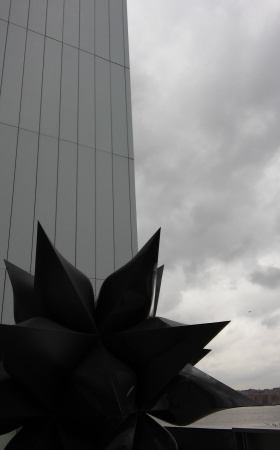
Outdoor terrace at the Whitney Museum of American Art.
The in-your-face intensity of so many human souls gathered close together in a large city confronts me with undeniable evidence of our ingenuity, grit, diversity, and grace. Whether it’s the unexpected spices on the duck breast I ordered for dinner, the efficiency of a crowded subway, a building packed with artwork, a novel architectural declaration, or a friendly greeting rendered in an unfamiliar accent, I come away awestruck at our capacity for invention, affability, and collaboration. I’m floored by the human ability to make things, and make things work. In the city, I’m all but assaulted by an astonishing wealth—not of money, although that’s certainly well in evidence—but of improvisation, hard work, adaptability, creativity, and perseverance.
Nice work, everybody.


Between Urban and…Urban
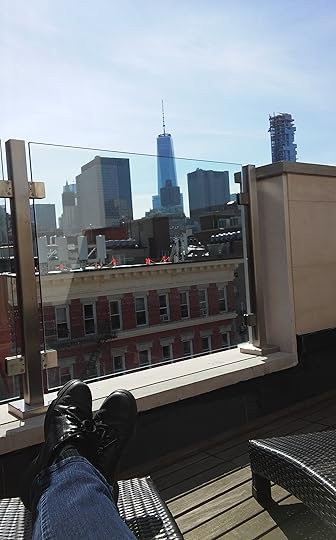
Relaxing on the terrace, looking on to the new One World Trade Center tower (center).
Even though we live in the sort of place most people escape TO, my hubby and I feel the impulse for a break now and then. Sometimes the change of place from this semi-arid ridge in central Colorado’s mountains is wet and coastal and occasionally it’s foreign, but often it’s a short city break. We eat in restaurants, take long walks on chewing-gum-freckled sidewalks, rely on public transportation.
There’s plenty about these trips that unsettles me. The charms of air travel withered long ago. I sleep poorly in noisy and over-illuminated cities. I’m distressed at how much harder it is to minimize my participation in the disposable economy while traveling. I’m unnerved by the press of people. I dislike the persistent befuddlement of being stripped of my insider’s native confidence. Yet for the brief interlude of a few days, spending time someplace that bears no resemblance to where we live, be it by sight, sound, smell, or rhythm, can be revitalizing.
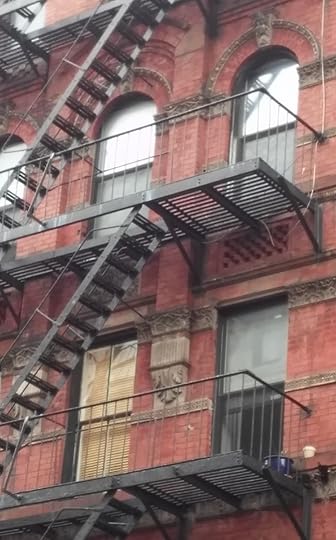
New York tenement neighborhood.
At the end of March, Doug and I flew to New York City to spend a few days in the urban frenzy and to visit my mom and brother. Doug had scored an online deal for a hotel and our time there aligned with a couple of days of fine spring weather. We socialized with family and friends and visited a couple of museums, but spent a lot of time wandering the streets, taking in the bustle and intricate choreography of that frenetic and assertively urban environment. In our temporary local neighborhood, we strolled past stores selling durian fruit, used restaurant equipment, shoes, high-end lighting, fancy clothes, cannolis. We strode streets and ambled avenues while dodging workers, tourists, bikes, food carts, and forests of steel construction scaffolding sprouting on walkways in every neighborhood. We squinted in the glare of glass-clad high-rises, admired the rusting fretwork of fire escapes on refurbished brick tenements, and noted that construction fashion trends have brought concrete back in vogue.
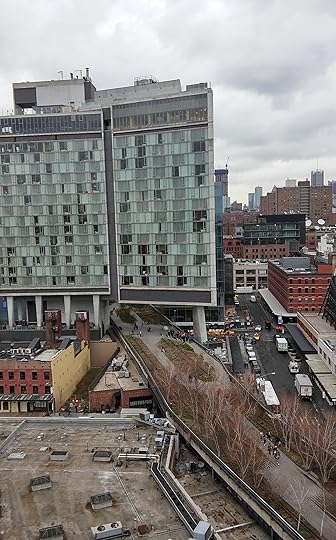
Overlooking the High Line and The Standard hotel from the Whitney.
The city is not the environment I claim as my own, and I’ve managed to arrange my life to hold the urban, the world of people, at a distance much of the time. The urban pole of my everyday existence consists mostly of books and words, of our house and outbuildings and vehicles and the infrastructures that support them, and of the technologies that enable my at-a-distance participation in twenty-first century society—including the electronics that allow me to publish these reflections.
There’s plenty about the human universe that makes me glad of my selective engagement, and I recognize that I’m privileged in being able to regulate my exposure. Somewhere in the course of every single day I find opportunity to consider what human arrogance, cruelty, or apathy has most recently wrought.
In the city, you’d think all that would be amplified, and in some respects it is. The human imprint in a place like New York is so profound that it takes special attention to detect anything of the wild. I can’t help but ponder the hubris of hiding our collective human reliance on natural systems beneath clever systems of concrete, steel, and glass.
Beyond all that, though, and beyond the mental recalibration of a few days away from work routines and the refreshed sense of gratitude for my home place, an interlude of voluntary submission to the metropolitan crush matters to the point of necessity. Time in the urban environment reminds me that all the negatives arise, in part, because people are such amazing animals.
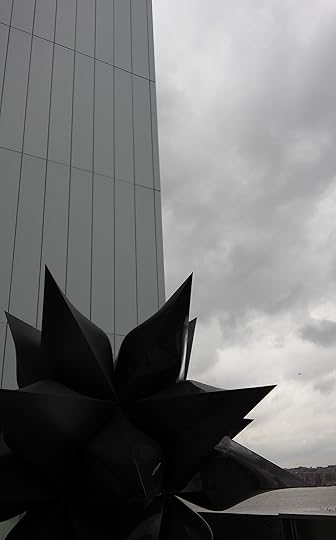
Outdoor terrace at the Whitney Museum of American Art.
The in-your-face intensity of so many human souls gathered close together in a large city confronts me with undeniable evidence of our ingenuity, grit, diversity, and grace. Whether it’s the unexpected spices on the duck breast I ordered for dinner, the efficiency of a crowded subway, a building packed with artwork, a novel architectural declaration, or a friendly greeting rendered in an unfamiliar accent, I come away awestruck at our capacity for invention, affability, and collaboration. I’m floored by the human ability to make things, and make things work. In the city, I’m all but assaulted by an astonishing wealth—not of money, although that’s certainly well in evidence—but of improvisation, hard work, adaptability, creativity, and perseverance.
Nice work, everybody.
March 18, 2016
A Monotony of Mild
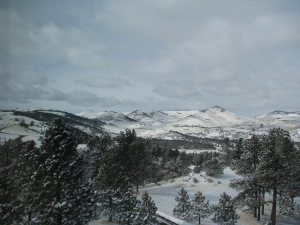
Just enough snow to cover the ground.
The winter started out cold—fiercely so, in fact. Icy air preserved the scanty accumulation from small snowstorms for weeks, solidifying it to slick veneers anywhere it was packed down—on roads, on the pathway I follow to and from the barn. The thin snow cover lingered for weeks under the oblique winter angle of the sun. By January, even though we were enjoying those additional minutes of daylight each day, I was braced—for bitter winds, for more ice, for the drifts that would pile up as storms fueled by an El Niño weather pattern delivered us a winter to remember.
Instead, it got warmer. Since the first of the year, we’ve received exactly three snowstorms of four inches or more–and the biggest of those was less than seven inches. Over the weeks between each storm, mild temperatures and breezy winds whittled away the snow, leaving nothing other than a few shabby drifts and grayish rags at the feet of the evergreens on north-facing slopes. Rather than El Niño, we’ve gotten El Nothing-o.
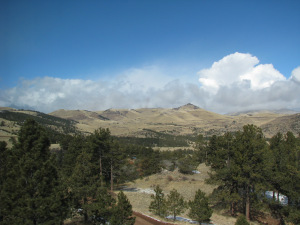
Beautiful…but mostly unchanged for months.
Despite the near-absence of winter, I find myself ready for spring. The press of snow clearly isn’t what’s weighing me down, and it’s not that I’m craving balmy temperatures, either. The weather so far in March, has been, like all of February and most of January, freakishly warm. No, the object of my desire isn’t a thaw, but a break in the monotony of mild.
Winters up here are long, but they’re also dynamic. Snowstorms—even the little ones—remake the landscape. The canvas doesn’t stay blank for long; the snow records the passage of animals and is etched with sinuous patterns by the wind. The sun applies a deft hand on all but the very coldest of days, sketching dimension and contrast with a heat-based technique that selectively erases the gesso of snow.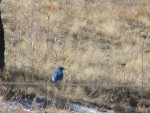
Without snowstorms, the melt-paintings haven’t been on display lately, and as much as I love the sepia-tinted landscape of our winter grasslands, I’m ready for a change. My eyes have begun thrill-seeking, hunting for color. They lock on the vibrant flash of 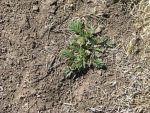 the mountain bluebirds that began showing up in late February, fluttering from fence wire to ground to pine bough to ground to fence post like scraps of wind-flown cerulean silk. Out in the pasture, rosettes of cinquefoil leaves unfold in puddles: tiny but assertively green. My heart gives a little lurch at the sight of the season’s first crocus ready to unfurl its purple-veined petals in the
the mountain bluebirds that began showing up in late February, fluttering from fence wire to ground to pine bough to ground to fence post like scraps of wind-flown cerulean silk. Out in the pasture, rosettes of cinquefoil leaves unfold in puddles: tiny but assertively green. My heart gives a little lurch at the sight of the season’s first crocus ready to unfurl its purple-veined petals in the 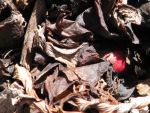 protected space of the garden. In another planting bed, the bright red capsule protecting a wadded leaf of rhubarb peeks from under last fall’s dead brown leaves.
protected space of the garden. In another planting bed, the bright red capsule protecting a wadded leaf of rhubarb peeks from under last fall’s dead brown leaves.
Flutters. Glimpses. Peeks. Not entirely satisfying. The reticence, even in the face of so many weeks of unusually warm weather, it appropriate, however. That there isn’t a lot going on is exactly how it should be, since technically it’s still winter up here—and will be for weeks after the upcoming equinox.
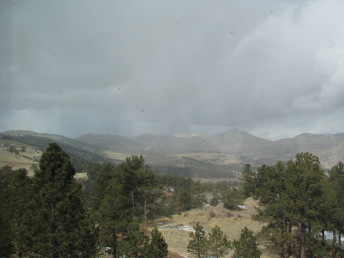
Not a blizzard, just a flurry.
Part of the problem, I think, is that I’m missing the bluster of March blizzards. The irony of spring up here is that it rides in on wintry weather: fast-moving storms that blow through with whiteout drama one day and eye-searing sunny brilliance the next. I’d be happy for the sloppy plop of spring snow slipping off the evergreen boughs. I wouldn’t mind heaving some heavy shovels-full off the front steps, splatting the slush onto the flowerbeds. My eyes are restless, but my nose is, too. With no snow to melt, there’s no mud to scent the air with the tantalizing promise of wet earth.


A Monotony of Mild
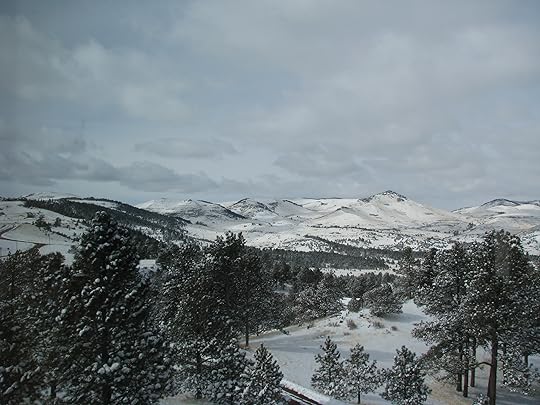
Just enough snow to cover the ground.
The winter started out cold—fiercely so, in fact. Icy air preserved the scanty accumulation from small snowstorms for weeks, solidifying it to slick veneers anywhere it was packed down—on roads, on the pathway I follow to and from the barn. The thin snow cover lingered for weeks under the oblique winter angle of the sun. By January, even though we were enjoying those additional minutes of daylight each day, I was braced—for bitter winds, for more ice, for the drifts that would pile up as storms fueled by an El Niño weather pattern delivered us a winter to remember.
Instead, it got warmer. Since the first of the year, we’ve received exactly three snowstorms of four inches or more–and the biggest of those was less than seven inches. Over the weeks between each storm, mild temperatures and breezy winds whittled away the snow, leaving nothing other than a few shabby drifts and grayish rags at the feet of the evergreens on north-facing slopes. Rather than El Niño, we’ve gotten El Nothing-o.
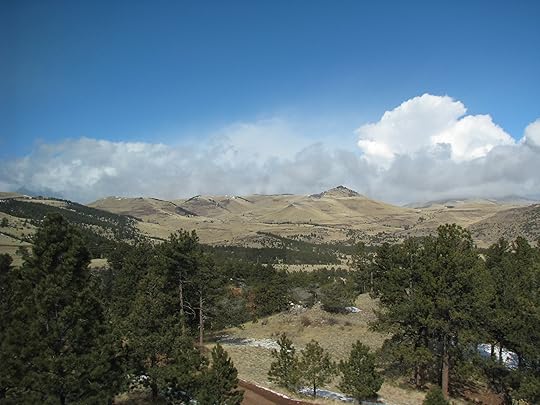
Beautiful…but mostly unchanged for months.
Despite the near-absence of winter, I find myself ready for spring. The press of snow clearly isn’t what’s weighing me down, and it’s not that I’m craving balmy temperatures, either. The weather so far in March, has been, like all of February and most of January, freakishly warm. No, the object of my desire isn’t a thaw, but a break in the monotony of mild.
Winters up here are long, but they’re also dynamic. Snowstorms—even the little ones—remake the landscape. The canvas doesn’t stay blank for long; the snow records the passage of animals and is etched with sinuous patterns by the wind. The sun applies a deft hand on all but the very coldest of days, sketching dimension and contrast with a heat-based technique that selectively erases the gesso of snow.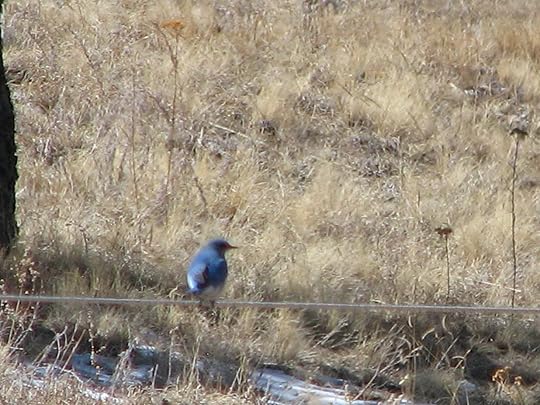
Without snowstorms, the melt-paintings haven’t been on display lately, and as much as I love the sepia-tinted landscape of our winter grasslands, I’m ready for a change. My eyes have begun thrill-seeking, hunting for color. They lock on the vibrant flash of 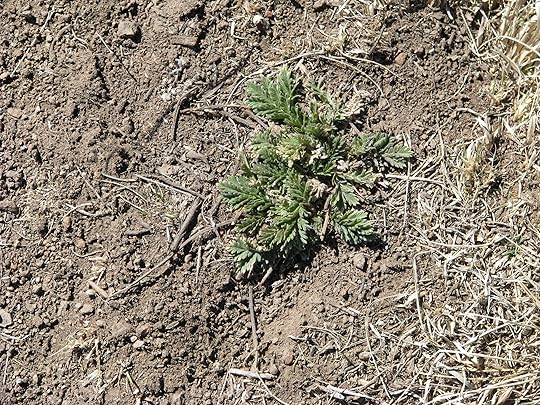 the mountain bluebirds that began showing up in late February, fluttering from fence wire to ground to pine bough to ground to fence post like scraps of wind-flown cerulean silk. Out in the pasture, rosettes of cinquefoil leaves unfold in puddles: tiny but assertively green. My heart gives a little lurch at the sight of the season’s first crocus ready to unfurl its purple-veined petals in the
the mountain bluebirds that began showing up in late February, fluttering from fence wire to ground to pine bough to ground to fence post like scraps of wind-flown cerulean silk. Out in the pasture, rosettes of cinquefoil leaves unfold in puddles: tiny but assertively green. My heart gives a little lurch at the sight of the season’s first crocus ready to unfurl its purple-veined petals in the 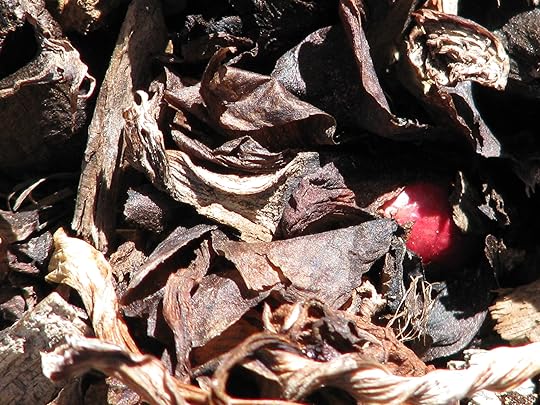 protected space of the garden. In another planting bed, the bright red capsule protecting a wadded leaf of rhubarb peeks from under last fall’s dead brown leaves.
protected space of the garden. In another planting bed, the bright red capsule protecting a wadded leaf of rhubarb peeks from under last fall’s dead brown leaves.
Flutters. Glimpses. Peeks. Not entirely satisfying. The reticence, even in the face of so many weeks of unusually warm weather, is appropriate, however. That there isn’t a lot going on is exactly how it should be, since technically it’s still winter up here—and will be for weeks after the upcoming equinox.
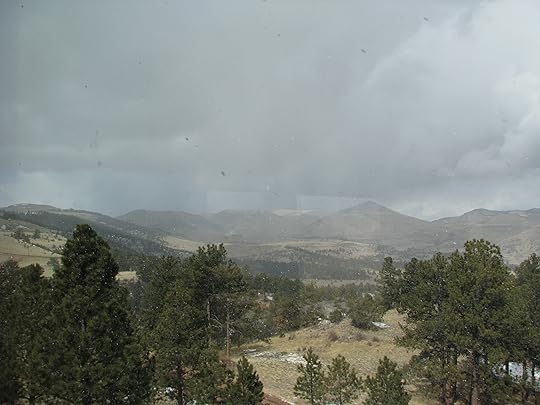
Not a blizzard, just a flurry.
Part of the problem, I think, is that I’m missing the bluster of March blizzards. The irony of spring up here is that it rides in on wintry weather: fast-moving storms that blow through with whiteout drama one day and eye-searing sunny brilliance the next. I’d be happy for the sloppy plop of spring snow slipping off the evergreen boughs. I wouldn’t mind heaving some heavy shovels-full off the front steps, splatting the slush onto the flowerbeds. My eyes are restless, but my nose is, too. With no snow to melt, there’s no mud to scent the air with the tantalizing promise of wet earth.

